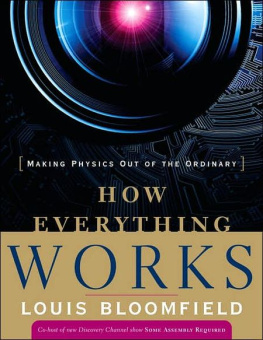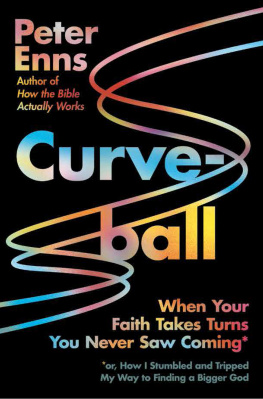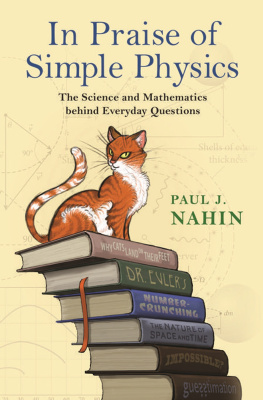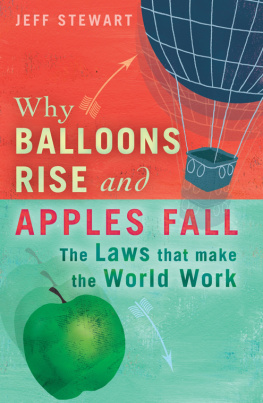Louis A. Bloomfield - How Everything Works: Making Physics Out of the Ordinary
Here you can read online Louis A. Bloomfield - How Everything Works: Making Physics Out of the Ordinary full text of the book (entire story) in english for free. Download pdf and epub, get meaning, cover and reviews about this ebook. publisher: Wiley, genre: Romance novel. Description of the work, (preface) as well as reviews are available. Best literature library LitArk.com created for fans of good reading and offers a wide selection of genres:
Romance novel
Science fiction
Adventure
Detective
Science
History
Home and family
Prose
Art
Politics
Computer
Non-fiction
Religion
Business
Children
Humor
Choose a favorite category and find really read worthwhile books. Enjoy immersion in the world of imagination, feel the emotions of the characters or learn something new for yourself, make an fascinating discovery.
- Book:How Everything Works: Making Physics Out of the Ordinary
- Author:
- Publisher:Wiley
- Genre:
- Rating:5 / 5
- Favourites:Add to favourites
- Your mark:
How Everything Works: Making Physics Out of the Ordinary: summary, description and annotation
We offer to read an annotation, description, summary or preface (depends on what the author of the book "How Everything Works: Making Physics Out of the Ordinary" wrote himself). If you haven't found the necessary information about the book — write in the comments, we will try to find it.
Why do golf balls have dimples?
How does an iPod turn binary digits into Bon Jovi?
How do microwave ovens cook?
How does a pitcher make a curveball curve and a knuckleball jitter?
Why dont you fall off an upside-down roller coaster?
If one didnt know better, one might think the world was filled with magicfrom the household appliances that make our lives easier to the devices that fill our world with sounds and images. Even a simple light bulb can seem mysterious when youre clueless about the science behind it.
Now in How Everything Works, Louis Bloomfield takes you inside the amazing gizmos and gadgets that are part of the fabric of our everyday life, explaining the physics that makes them work. Examining everything from roller coasters to radio, knuckleballs to nuclear weapons, How Everything Works reveals the answers to such questions as why the sky is blue, why metal is a problem in microwave ovens, how MRIs see inside you, and why some clothes require dry cleaning.
You dont need a science or engineering background to understand How Everything Works. All you need is an active curiosity about the extraordinary world all around you. Remarkably clear and always fascinating, How Everything Works is nothing short of a users manual for our everyday world.
ReviewBooks on how things work often adopt a format that gives equal space to each device described. So the flush toilet, say, might get the same number of words devoted to it as the internal-combustion engine, even though the latter is far more complicated. In How Everything Works: Making Physics Out of the Ordinary, Louis Bloomfield avoids that trap by taking just as long as he needs to explain things. And thats exactly what he does, explain things, his chapters having such titles as Things That Involve Light, Things That Move With Fluids, Things That Involve Chemical Physics and so forth. The result is something of a cross between those familiar (and often less-than-satisfying) how-it-works guides and a full-blown physics textbook.
Although Bloomfield demonstrates considerable knowledge about the history of science and technology, his aim is clearly to explain how things work rather than how they were developed. Thus his treatment of the transistor very appropriately jumps straight to the field-effect transistor, which is fairly easy to understand, without first explaining its more complex predecessor, the bipolar transistor.
Bloomfield also shows excellent judgment about how far to dive in. (One exception here is his cursory treatment of magnetic resonance imaging, a technology that is admittedly very difficult to explain in anything other than a superficial manner.) His section on the microwave oven, for example, helped me finally to understand how a cavity magnetron works. Bloomfield also straightened me out on the difference between a turbojet engine (above, right) and a turbofan engine (left), a distinction I hadnt at all appreciated. And he even clued me in on why thefront fork of a childs bike isnt curved forward. All but the most hard-core technophile should find many similar moments of enlightenment in this delightfully informative book.-- David Schneider
From the Inside FlapLouis A. Bloomfield: author's other books
Who wrote How Everything Works: Making Physics Out of the Ordinary? Find out the surname, the name of the author of the book and a list of all author's works by series.










